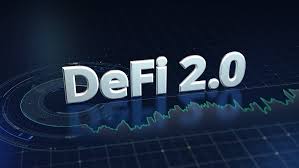The age of chaotic, purely retail-driven decentralized finance (DeFi) is slowly fading. Enter “DeFi 2.0” — the upgraded version of blockchain’s financial playground. And this time, it’s not just for tech geeks or daring crypto enthusiasts. Big players are taking notice. Pension funds, asset managers, even family offices are peeking into the world of on-chain liquidity, automated protocols, and tokenized real-world assets. The big question? Is DeFi finally ready for the big leagues?

From Wild West to Wall Street-Style Infrastructure
Back in the day (2019–2023), DeFi was thrilling — like a rollercoaster you didn’t want to get off. Yield farms offered eye-watering APYs, lending platforms promised quick profits, and liquidity pools could make or break your week. But with excitement came chaos: hacks, rug pulls, volatile crashes. Many protocols simply couldn’t deliver sustainable returns.
“If DeFi 1.0 was the wild west, DeFi 2.0 is bringing law and order — without killing the fun,” someone summed it up perfectly.
Now, the game is changing. Institutional-grade tools are emerging. Platforms aggregate trading workflows, layer-2 networks speed up transactions, and compliance, custody, and regulation are improving. Suddenly, DeFi isn’t just a playground — it’s becoming a workspace. And that matters. Institutions need trust, audited custody, clear rules, and real liquidity. Without these, DeFi was always going to be a niche experiment.
Why Institutions Are Peeking In
Several forces are nudging big investors toward DeFi 2.0:
-
- Liquidity & Market Breadth: On-chain venues are now deeper and broader than ever. Institutions can access markets that traditional exchanges barely touch.
-
- Efficiency & Speed: Transactions settle in seconds. Counterparty risk drops. Workflow headaches shrink. It’s tempting.
-
- Tokenized Real-World Assets (RWA): Imagine holding fractional real estate, debt, or other familiar instruments — all on-chain. Institutions can play in a space that feels, at least partially, like home.
-
- Safer Smart Contracts & Custody: New protocols come with better risk management, audits, and compliance measures — exactly what cautious investors need.
-
- Search for Yield & Diversification: With traditional bonds barely moving and risk assets wobbling, DeFi offers a chance for returns that just aren’t available elsewhere.
It’s tempting. Very tempting. But it’s not a free lunch.

Hurdles That Can’t Be Ignored
Despite the excitement, barriers remain. Institutions are understandably careful.
-
- Regulatory Fog: Even with strong tech, the law isn’t fully on DeFi’s side yet. Capital moves slowly when rules are murky.
-
- Smart Contract & Risk Concerns: High yields look great on paper. But one glitch can wipe out months of gains.
-
- Custody & Governance: Institutions operate at scale. They need multisig, insurance, audits, dashboards — features many protocols didn’t originally design for.
-
- Legacy Integration: On-chain systems need to talk to old-school finance. Not an easy task.
-
- Liquidity Limits: Some pools just aren’t deep enough for multi-million-dollar trades.
It’s like a thrilling ride you want to join, but you’re peeking over the safety bar, wondering if the harness will hold.
How Institutions Are Actually Allocating
So how are institutions experimenting without losing sleep? Carefully.
-
- Small satellite allocations into tokenized RWAs or regulated lending pools.
-
- Aggregated platforms combining centralized and decentralized liquidity — the best of both worlds.
-
- Conservative bets on spot Bitcoin and Ethereum, sidestepping broader, more volatile DeFi protocols.
The key takeaway? Institutions aren’t diving headfirst. They’re dipping toes. Layering in smart, controlled exposure rather than chasing flashy yields.
What DeFi 2.0 Means for Portfolios
Here’s what’s changing for the traditional investment world:
-
- Tokenized Access: Real-world assets now live on-chain, letting institutions experiment with fractional ownership and transparency.
-
- On-Chain Execution & Liquidity: Faster, cheaper, less risky trades than traditional OTC or exchange-based approaches.
-
- Hybrid Governance: Protocols mix decentralization with compliance-friendly structures — KYC, multisig, and audit trails that speak institutional language.
In short, portfolios can now treat some DeFi allocations like any other alternative asset. But cautiously. Very cautiously.
Peering Into the Future
The next few years could be transformative:
-
- Regulatory clarity may open the floodgates for institutional capital.
-
- Institutional-focused protocols designed for governance, audits, and insurance will proliferate.
-
- Tokenized funds could become the ETF equivalent for DeFi.
-
- Seamless CeFi/DeFi integration will make on-chain assets feel like part of the everyday toolkit.
-
- Programmable, smart contract-driven funds could automate risk management while keeping humans in control.
The promise is tantalizing. The reality? Still emerging.

Final Thoughts
DeFi 2.0 isn’t just tech evolution. It’s a cultural shift — a bridge between the anarchic past and a future where institutions can participate without losing control.
Sure, caution rules for now. Regulation, smart contract risks, and operational integration remain barriers. But the question has shifted from “should institutions engage?” to “how?”
For portfolio managers, this is a brave new world. DeFi is no longer a playground. It’s an experiment with real teeth, real governance, and real opportunity. And if managed carefully, it may just become a standard tool in the institutional toolkit — innovative, decentralized, yet disciplined.
If you want to explore crypto ETFs, see